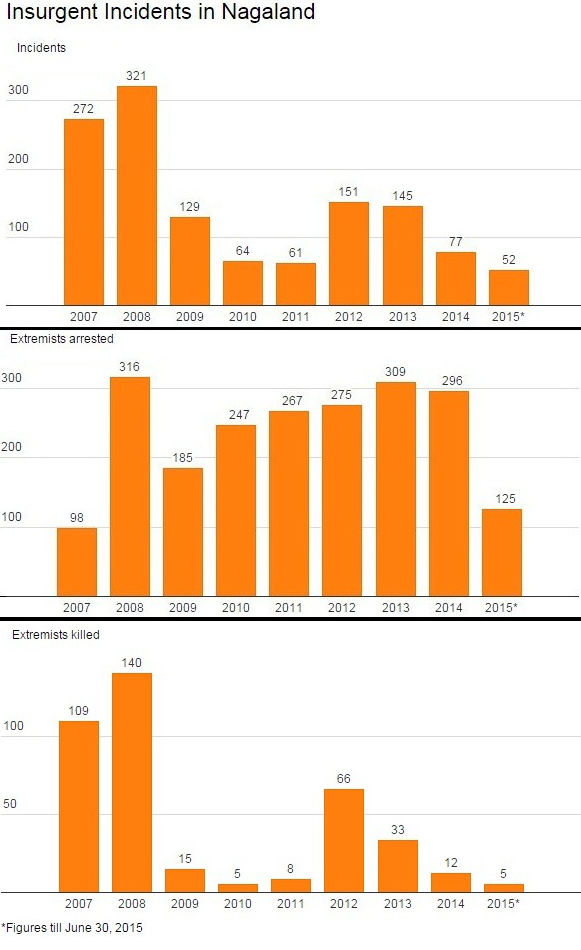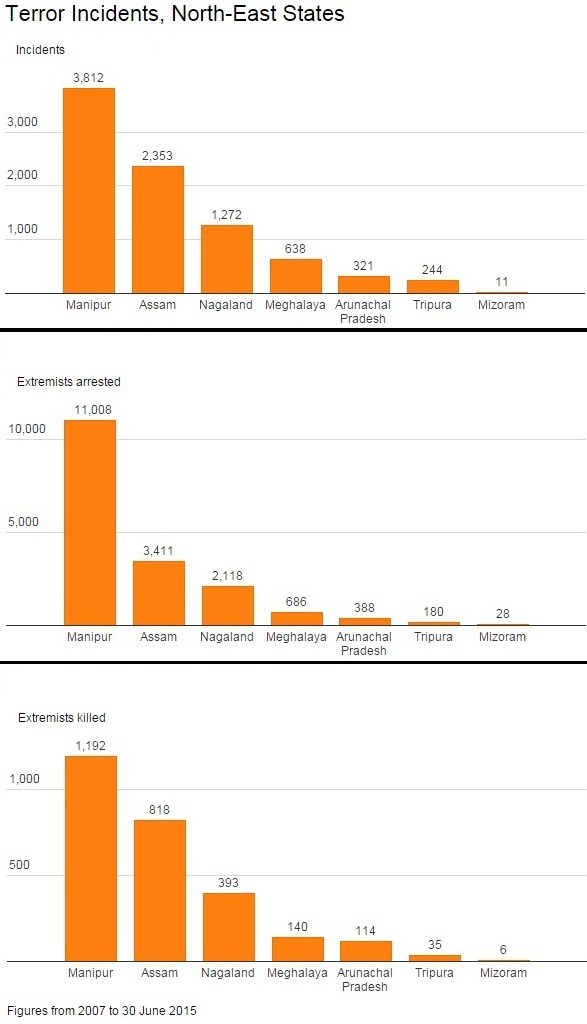The fourth and latest peace agreement over 68 years was signed between the government of Prime Minister Narendra Modi and the National Socialist Council of Nagaland (Isak Muivah group), the state’s chief rebel outfit, on August 3, 2015.
The agreement – the details of which are not yet clear – could, hopefully, end India’s oldest insurgency and substantially restore peace in a troubled region. Also unclear are the reactions of rival factions, notably the NSCN (Khaplang), the outfit that ambushed and killed 18 Indian soldiers on June 4, 2015.
Modi, who was present during the signing of the peace agreement, lauded the courage and wisdom of the Naga leaders, and thanked them for their cooperation.
Here’s a look at earlier agreements signed by state and central governments and Naga rebels:
NSCN (IM) had signed a ceasefire agreement with the government in 1997, which was extended indefinitely in July 2007.
Insurgent incidents declined following the cease-fire with the dominant NSCN (IM).
The other factions of NSCN are NSCN (Khole-Kitovi), NSCN (Reformation) and NSCN (Khaplang). A ceasefire signed with NSCN/R & KK is valid till April 27, 2016.
However, insurgent incidents continue as the region is India’s original hot spot of insurgency, and the minority NSCN (Khaplang) faction has not agreed to the cease-fire.
Nagaland, the northeast’s third-deadliest place
Nagaland with 1,271 insurgent incidents over the past eight years is the third-deadliest north-east state after Manipur (3,812) and Assam (2,353), according to data released by Ministry of Home Affairs.
The state has reported 393 insurgent deaths and 2,118 arrests between 2007 and June 30, 2015. While 13 security personnel have died, 158 civilians have been killed and 629 have been kidnapped.
Two people are killed daily in the northeast
Arunachal Pradesh, Assam, Manipur, Meghalaya, Mizoram, Nagaland and Tripura, known as the ‘Seven Sisters’, has turned into a battle ground over the years. Assam constitutes nearly 54% of all civilian deaths in the north-east states.
Sikkim, also a part of India’s north-east region and the eighth north-eastern state, is free from terrorist activities.
On an average, nearly two people are killed every day: 569 lives (including-extremists, civilians and security forces) are lost each year in the north-eastern states.
The states witnessed 8,651 insurgent incidents between 2007 and June 30 2015; 2,698 extremists were killed; 17,819 arrested and 7,494 surrendered. While 1,832 civilians died, 2,545 are reported to be kidnapped.
No succour for deadly Manipur
Manipur is the deadliest north-eastern state with about 15 violent outfits representing different tribes and communities.
About 1,192 extremists have been killed and over 11,000 arrested over the past eight years.
The Indian army’s 21 Para unit carried out a secret cross-border operation along the Indo-Myanmar border on June 9 to avenge the killing of 18 Indian soldiers by terrorists. About 20 militants were reported to be killed.
These militants were believed to be a mixed group of Meitei militants, led by the Kanglei Yawol Kanna Lup (KYKL) faction, while intelligence agencies point to the Khaplang faction of the NSCN as the main player.
The north-east is also the deadliest place for Indian security forces in 2015, IndiaSpend had reported earlier. Over 300 army and paramilitary soldiers and police officers have been killed over the past eight years.
Despite accords and ceasefire agreements, insurgency continued in these areas. Even after the 1997 ceasefire between NSCN (IM) and the government, there have been several insurgent attacks.
This article was originally published on IndiaSpend.com, a data-driven and public-interest journalism non-profit.
The agreement – the details of which are not yet clear – could, hopefully, end India’s oldest insurgency and substantially restore peace in a troubled region. Also unclear are the reactions of rival factions, notably the NSCN (Khaplang), the outfit that ambushed and killed 18 Indian soldiers on June 4, 2015.
Modi, who was present during the signing of the peace agreement, lauded the courage and wisdom of the Naga leaders, and thanked them for their cooperation.
Here’s a look at earlier agreements signed by state and central governments and Naga rebels:

Source: National Institute of Advanced Studies/The Indian Express
NSCN (IM) had signed a ceasefire agreement with the government in 1997, which was extended indefinitely in July 2007.
Insurgent incidents declined following the cease-fire with the dominant NSCN (IM).
The other factions of NSCN are NSCN (Khole-Kitovi), NSCN (Reformation) and NSCN (Khaplang). A ceasefire signed with NSCN/R & KK is valid till April 27, 2016.
However, insurgent incidents continue as the region is India’s original hot spot of insurgency, and the minority NSCN (Khaplang) faction has not agreed to the cease-fire.
Nagaland, the northeast’s third-deadliest place
Nagaland with 1,271 insurgent incidents over the past eight years is the third-deadliest north-east state after Manipur (3,812) and Assam (2,353), according to data released by Ministry of Home Affairs.
The state has reported 393 insurgent deaths and 2,118 arrests between 2007 and June 30, 2015. While 13 security personnel have died, 158 civilians have been killed and 629 have been kidnapped.

Source: Ministry of Home Affairs
Two people are killed daily in the northeast
Arunachal Pradesh, Assam, Manipur, Meghalaya, Mizoram, Nagaland and Tripura, known as the ‘Seven Sisters’, has turned into a battle ground over the years. Assam constitutes nearly 54% of all civilian deaths in the north-east states.
Sikkim, also a part of India’s north-east region and the eighth north-eastern state, is free from terrorist activities.
On an average, nearly two people are killed every day: 569 lives (including-extremists, civilians and security forces) are lost each year in the north-eastern states.
The states witnessed 8,651 insurgent incidents between 2007 and June 30 2015; 2,698 extremists were killed; 17,819 arrested and 7,494 surrendered. While 1,832 civilians died, 2,545 are reported to be kidnapped.

Source: Ministry of Home Affairs
No succour for deadly Manipur
Manipur is the deadliest north-eastern state with about 15 violent outfits representing different tribes and communities.
About 1,192 extremists have been killed and over 11,000 arrested over the past eight years.
The Indian army’s 21 Para unit carried out a secret cross-border operation along the Indo-Myanmar border on June 9 to avenge the killing of 18 Indian soldiers by terrorists. About 20 militants were reported to be killed.
These militants were believed to be a mixed group of Meitei militants, led by the Kanglei Yawol Kanna Lup (KYKL) faction, while intelligence agencies point to the Khaplang faction of the NSCN as the main player.
The north-east is also the deadliest place for Indian security forces in 2015, IndiaSpend had reported earlier. Over 300 army and paramilitary soldiers and police officers have been killed over the past eight years.
Despite accords and ceasefire agreements, insurgency continued in these areas. Even after the 1997 ceasefire between NSCN (IM) and the government, there have been several insurgent attacks.
This article was originally published on IndiaSpend.com, a data-driven and public-interest journalism non-profit.
Limited-time offer: Big stories, small price. Keep independent media alive. Become a Scroll member today!
Our journalism is for everyone. But you can get special privileges by buying an annual Scroll Membership. Sign up today!